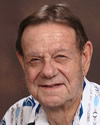 William R. Dickinson |
2014 Rip Rapp Archaeological Geology Award
Presented to William R. Dickinson
Citation by David Killick
This is the third time that William (Bill) Dickinson has been honored by the Geological Society of America. He was awarded the Penrose Medal in 1991, and the Laurence L. Sloss Award for Sedimentary Geology in 1999. He was also elected to the National Academy of Sciences in 1992 for his extraordinary volume of research combining sedimentary petrology with tectonics, applied particularly to reconstructing the geological evolution of the Pacific and of North America. Yet very few of those who know Bill as a towering figure in these fields realize that he has also had a parallel career in archaeological geology that began in 1965 and has so far produced 121 publications.
Bill Dickinson’s contributions to archaeological geology have had two foci. The first has been to track the earliest migrations of humans into the Pacific between 1200 and 750 BCE. He has done this by quantitative optical petrography of the Lapita pottery that the migrants took with them. By comparing the frequency of mineral and lithic temper grains in these sherds to those of temper sands that he and his collaborating archaeologists have systematically collected on Pacific islands, Bill has been able to identify the starting points for most of these voyages. These data have been enormously important in reconstructing the earliest settlement of western Polynesia.
His second major contribution to archaeology has been on the geomorphology of Pacific islands, whose present shorelines differ from those encountered by the earliest Lapita voyagers because of mid- Holocene sea-level changes and subsequent isostatic uplift. These studies have been immensely helpful in prospecting for archaeological sites of Lapita age.
The many letters received in support of this nomination testify to the reverence of many Pacific archaeologists for Bill Dickinson as a person, and for their very high regard for his work. There can be no more deserving recipient of the Rip Rapp Award for Archaeological Geology.
 2014 George (Rip) Rapp Archaeological Geology Award — Response by William R. Dickinson
2014 George (Rip) Rapp Archaeological Geology Award — Response by William R. Dickinson
When I first put my standard specialties of sedimentary geology and tectonics to work in the service of geoarchaeology a half century ago, I had no inkling that effort would gain me such a signal and unexpected honor. I stand here infused with a mixture of humility, pride, and unalloyed joy.
I took my first step into geoarchaeology in 1965 as a sidelight to mapping the Wainimala orogen and its cover rocks on Viti Levu in Fiji with a Guggenheim Fellowship during my first sabbatical from Stanford. Laurence and Helen Birks were at the same time excavating the famed Lapita ceramic site beneath the Sigatoka sand dunes on the south coast. At the time, it was unclear whether Lapita ware was fabricated at some central entrepot in Melanesia, to be carried from there across some 4000 km of the South Pacific, or whether it was made locally on the multiple islands where it is now found. To approach that issue, I undertook a study of the sedimentology and sedimentary petrography of the Sigatoka dune sands in parallel with a study of the temper sands embedded in Sigatoka pottery. Without a doubt, the pottery was tempered with local sand.
On my way home from Fiji, I stopped by the Bishop Museum in Honolulu where Richard Shutler, Jr. (deceased 2007) was serendipitously in residence for a year. Richard knew the value of geology to archaeology, having been the first scientist in charge of the radiocarbon laboratory at the University of Arizona. We hatched the scheme of applying sedimentary petrography to the study of temper sands in Lapita and other ceramic traditions throughout the South Pacific arena. Our co-conspirator from the outset was Roger Green (deceased 2009), the acknowledged doyen of South Pacific archaeology at the University of Auckland.
As my research unfolded over the years, potsherds were gratefully received from around 100 archaeological collaborators working on at least 150 islands, and have produced perhaps 2850 thin sections as grist for interpretations. It is by now abundantly clear that it was by and large the potmakers who migrated through the islands of Pacific Oceania over the centuries plying their ancestral skills, and not the pots that moved. Still and all, the same investigative technique has also documented ceramic transfer in limited volume between more than 75 pairs of islands, thereby revealing specific and otherwise undemonstrable cultural ties.
After my retirement from teaching in 1991, able to spend two to four months a year in the islands, I turned my attention to the influence of hydro-isostasy and lithospheric flexure on the evolution of Holocene paleoshorelines where so much archaeology is focused within Pacific Oceania. Since my pursuit of that topic coincided with an era of easy air access to 60 airstrips on multiple far-flung islands, it seems likely that my wife Jackie and I have walked more miles of island shorelines than anyone who ever lived.
I could literally run on for hours but my allotted time is up. Peace be with you all!
